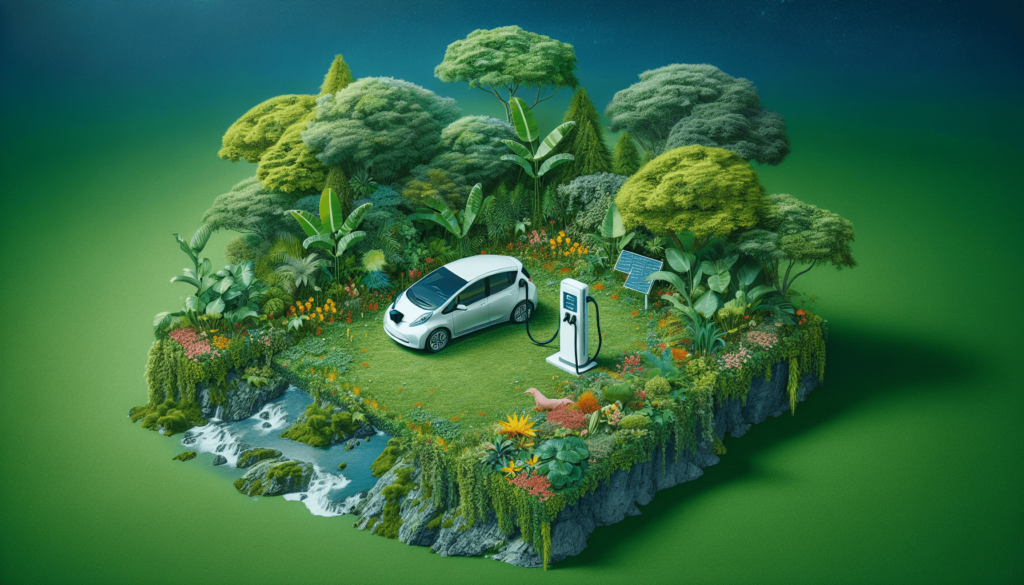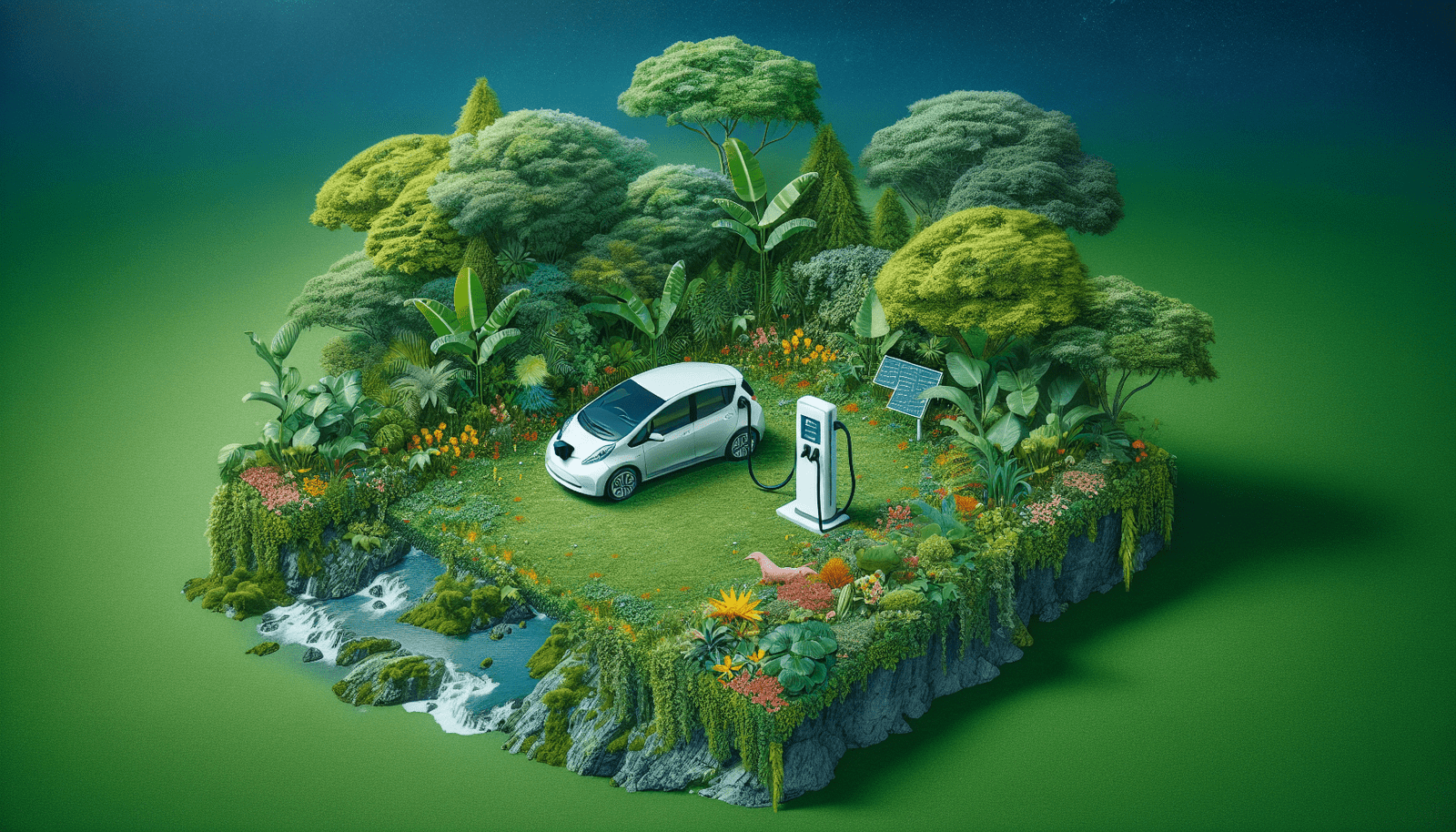Imagine a future where the roads hum with the soft hum of electric vehicles, and the air is free of exhaust fumes. In this world, our precious natural habitats and ecosystems thrive, unburdened by the harmful effects of combustion engines. Electric vehicles hold the key to a greener, cleaner future, as they produce zero tailpipe emissions and reduce our dependence on fossil fuels. By making the switch to electric vehicles, we can make a significant impact on preserving and protecting our fragile natural world for generations to come.

Reducing greenhouse gas emissions
Lowering carbon dioxide emissions
By switching to electric vehicles, you can significantly contribute to the reduction of carbon dioxide emissions. Unlike gasoline-powered cars, electric vehicles do not produce tailpipe emissions, which are a major source of carbon dioxide and other greenhouse gases. By choosing to drive an electric vehicle, you are actively taking steps to lower your carbon footprint and combat climate change. This reduction in carbon dioxide emissions plays a crucial role in preserving the delicate balance of our ecosystems and protecting natural habitats.
Decreasing air pollution
In addition to lowering carbon dioxide emissions, electric vehicles also help in decreasing air pollution. Traditional gasoline-powered vehicles emit harmful pollutants such as nitrogen oxides, particulate matter, and carbon monoxide into the atmosphere. These pollutants can have detrimental effects on both our health and the health of ecosystems. By driving electric vehicles, which produce zero tailpipe emissions, you are contributing to cleaner air quality and minimizing the negative impact on natural environments.
Minimizing the release of other greenhouse gases
While carbon dioxide is a well-known greenhouse gas, there are other gases that also contribute to climate change. Electric vehicles help minimize the release of these greenhouse gases, such as methane and nitrous oxide. Methane, primarily emitted from the extraction and transportation of fossil fuels, is an incredibly potent greenhouse gas. By shifting to electric vehicles, which rely on electricity from renewable energy sources, we can significantly reduce the release of methane and other greenhouse gases. This reduction plays a vital role in preserving the delicate balance of ecosystems.
Conserving fossil fuels
Decreasing oil consumption
By using electric vehicles, you can decrease your reliance on fossil fuels, particularly oil. Traditional vehicles depend on gasoline or diesel, which are derived from finite fossil fuel reserves. The extraction and consumption of these fuels have severe environmental consequences, including habitat destruction, water pollution, and greenhouse gas emissions. Electric vehicles, on the other hand, use electricity stored in batteries to power their engines. By reducing the demand for oil, we can preserve natural habitats, protect ecosystems, and reduce the need for environmentally destructive practices associated with fossil fuel extraction.
Reducing reliance on non-renewable resources
In addition to decreasing oil consumption, electric vehicles play a crucial role in reducing our overall reliance on non-renewable resources. Fossil fuels, such as coal and natural gas, are limited in supply and have detrimental environmental impacts. By transitioning to electric vehicles, which can be powered by renewable energy sources such as solar or wind, we can reduce the strain on non-renewable resources and promote a sustainable energy future. This shift not only helps protect natural habitats affected by resource extraction but also contributes to the long-term conservation of ecosystems.
Preserving natural habitats affected by fossil fuel extraction
The extraction and transportation of fossil fuels often lead to habitat destruction and habitat fragmentation. These activities can disrupt ecosystems, displace wildlife, and contribute to the loss of biodiversity. Electric vehicles offer a solution by reducing the need for fossil fuel extraction and the associated impacts on natural habitats. By adopting electric vehicles, we can help protect and preserve the delicate balance of ecosystems, allowing for the continued existence of diverse species and the health of natural habitats.
Reducing noise pollution
Limiting noise disturbances for wildlife
Traditional vehicles, with their internal combustion engines, produce significant amounts of noise pollution. This noise pollution can have detrimental effects on wildlife, particularly species that rely on sound for communication, navigation, and hunting. Electric vehicles, on the other hand, operate quietly, with their electric motors producing minimal noise. By driving electric vehicles, you can help limit noise disturbances for wildlife, allowing them to thrive and maintain their natural behaviors undisturbed.
Preserving natural soundscapes
In addition to protecting wildlife, electric vehicles contribute to the preservation of natural soundscapes. Noise pollution from human activities, including traffic noise, can disrupt the natural soundscape of an area. This disruption not only affects wildlife but also diminishes the overall experience of being in nature. By choosing electric vehicles, which emit minimal noise, you are helping preserve the tranquil and immersive sound environments of natural habitats. This preservation enhances our connection with the natural world and promotes a sense of tranquility and well-being.
Minimizing stress on ecosystems caused by noise
Noise pollution can have far-reaching impacts on ecosystems. It can disturb breeding patterns, alter predator-prey dynamics, and disrupt the behavior and communication of wildlife. By minimizing noise pollution through the adoption of electric vehicles, we can reduce stress on ecosystems. This reduction in stress allows for the natural functioning of ecosystems and helps maintain the delicate balance of species interactions. By considering the impact of noise on natural habitats and choosing electric vehicles, we can actively contribute to the well-being and persistence of ecosystems.
Preventing water pollution
Eliminating oil spills from vehicles
Oil spills from vehicles, particularly during accidents or improper disposal of used oil, can have severe consequences on water bodies and aquatic habitats. These oil spills contaminate water, harm aquatic life, and disrupt the overall health of ecosystems. Electric vehicles, with their absence of oil-based fuels, eliminate the risk of oil spills and contribute to the prevention of water pollution. By opting for electric vehicles, you are actively promoting the protection of aquatic habitats, ensuring the conservation of water resources, and safeguarding the biodiversity that relies on these ecosystems.
Reducing the runoff of pollutants from conventional vehicles
Conventional vehicles, such as those powered by gasoline or diesel, emit pollutants that can be washed into water bodies through runoff. These pollutants, including oil, heavy metals, and chemicals, have detrimental effects on water quality and the organisms that rely on these freshwater ecosystems. Electric vehicles, with their clean energy sources and zero tailpipe emissions, significantly reduce the runoff of these pollutants, thus minimizing water pollution. By driving electric vehicles, you are actively participating in the preservation of clean and healthy water bodies for the benefit of both humans and aquatic life.
Protecting aquatic habitats and ecosystems
Water pollution poses a significant threat to aquatic habitats and ecosystems. It disrupts the delicate balance of ecosystems, harms aquatic organisms, and contributes to the loss of biodiversity. Electric vehicles, by eliminating tailpipe emissions and reducing the use of polluting chemicals, play a vital role in protecting aquatic habitats. By choosing electric vehicles, you are actively contributing to the conservation and preservation of these valuable ecosystems. This protection ensures the continued existence of various species and safeguards the vital role these habitats play in supporting life on Earth.

Preserving air quality
Lowering emissions of pollutants like nitrogen oxides
Nitrogen oxides (NOx) are a group of harmful pollutants that contribute to air pollution and have adverse effects on human health and ecosystems. Traditional vehicles emit NOx through the combustion of fossil fuels, exacerbating air pollution. Electric vehicles, on the other hand, produce zero tailpipe emissions and therefore do not contribute to the release of nitrogen oxides. By driving electric vehicles, you are actively participating in the reduction of nitrogen oxide emissions and promoting better air quality for everyone. This reduction in pollutants plays a crucial role in preserving the health and integrity of ecosystems.
Reducing the formation of ground-level ozone
Ground-level ozone is a harmful air pollutant formed when nitrogen oxides and volatile organic compounds react in the presence of sunlight. High levels of ground-level ozone have detrimental effects on human health, vegetation, and ecosystems. Electric vehicles, by eliminating tailpipe emissions and reducing the release of nitrogen oxides and volatile organic compounds, help prevent the formation of ground-level ozone. By choosing electric vehicles, you are actively contributing to the preservation of air quality and minimizing the negative impacts of ground-level ozone on ecosystems and natural areas.
Improving the overall air quality in natural areas
The overall air quality in natural areas is vital for the health and sustainability of ecosystems. Poor air quality can harm vegetation, disrupt ecological processes, and contribute to the loss of biodiversity. Electric vehicles, with their zero tailpipe emissions, contribute to the improvement of air quality in natural areas. By driving electric vehicles, you are actively supporting the preservation of clean and healthy air in these environments, ensuring the well-being of wildlife and the overall health of ecosystems. This preservation is crucial in maintaining the delicate balance of natural areas and promoting their long-term sustainability.
Mitigating habitat fragmentation
Reducing the need for new roads
The construction of new roads often leads to habitat fragmentation, a significant threat to wildlife and ecosystems. New roads can disrupt animal migration patterns, limit access to essential resources, and fragment habitats, isolating species populations and reducing genetic diversity. Electric vehicles play a vital role in mitigating habitat fragmentation by reducing the need for new roads. By advocating for electric vehicles and supporting sustainable transportation solutions, you are actively helping preserve the connectivity of natural habitats, allowing wildlife to move freely and maintaining healthy ecosystems.
Minimizing the negative impact of road construction on ecosystems
Road construction, particularly in ecologically sensitive areas, can have severe impacts on ecosystems. It can lead to habitat destruction, soil erosion, and the loss of crucial habitats for wildlife. Electric vehicles help mitigate the negative impacts of road construction by reducing the need for new roads and associated infrastructure. By choosing electric vehicles, you are actively promoting the preservation of ecosystems and minimizing the disturbance and destruction caused by road construction. This preservation is essential to maintain the biodiversity, ecological processes, and overall health of natural habitats.
Maintaining connectivity between natural habitats for wildlife
The connectivity of natural habitats is essential for the survival and well-being of wildlife. Habitat fragmentation disrupts this connectivity, limiting the movement and genetic exchange between populations. Electric vehicles, by reducing the need for road construction and promoting sustainable transportation solutions, play a crucial role in maintaining the connectivity of natural habitats. By supporting electric vehicles, you are actively contributing to the preservation of wildlife corridors and ensuring the long-term sustainability of diverse species and healthy ecosystems. This connectivity is vital for maintaining ecological balance and allowing for the adaptation and resilience of wildlife populations.
Promoting sustainable land use
Encouraging the adoption of electric vehicles in urban areas
Urban areas often face significant challenges in terms of air pollution, traffic congestion, and habitat destruction. Electric vehicles offer a sustainable transportation solution that can help address these challenges. By encouraging the adoption of electric vehicles in urban areas, we can reduce air pollution, alleviate traffic congestion, and minimize the need for expansive road networks. This promotes sustainable land use by preserving natural habitats, avoiding urban sprawl, and creating more livable and healthy environments for both humans and wildlife.
Preserving natural habitats by avoiding urban sprawl
Urban sprawl is characterized by the unchecked expansion of urban areas into surrounding natural habitats. This process leads to the destruction and fragmentation of ecosystems, loss of biodiversity, and the degradation of natural resources. Electric vehicles offer a sustainable solution by reducing the need for urban sprawl. By adopting electric vehicles and promoting sustainable transportation options, we can minimize the demand for new infrastructure and land development. This preservation of natural habitats ensures the conservation of ecosystems, protects biodiversity, and promotes sustainable land use practices.
Supporting effective land management strategies
Effective land management plays a crucial role in preserving natural habitats and ecosystems. Electric vehicles contribute to effective land management by reducing the pressure on land resources associated with traditional transportation systems. By supporting the adoption of electric vehicles, we can reduce the need for extensive road networks, parking lots, and fueling infrastructure. This reduction in infrastructure demands allows for more effective land management practices, protecting valuable natural habitats, and promoting sustainable land use. By choosing electric vehicles, you are actively participating in the preservation of natural environments and supporting sustainable land management strategies.
Supporting renewable energy integration
Increasing demand for renewable electricity
The integration of renewable energy sources in our electricity grid is crucial for a sustainable future. Electric vehicles play a vital role in supporting this transition by increasing the demand for renewable electricity. By choosing to drive electric vehicles, you are indirectly supporting the growth of renewable energy technologies such as solar and wind power. This increased demand for clean energy sources helps accelerate the development and deployment of renewable energy infrastructure, reducing our reliance on fossil fuel power plants and promoting the conservation of natural habitats and ecosystems.
Enhancing the development of clean energy infrastructure
The development and deployment of clean energy infrastructure are essential for transitioning to a sustainable energy system. Electric vehicles contribute to this enhancement by providing a significant incentive for the growth of clean energy technologies. The increased demand for electricity from electric vehicles drives the expansion of renewable energy infrastructure such as solar farms and wind turbines. This expansion reduces our reliance on fossil fuel power plants, decreases greenhouse gas emissions, and minimizes the impacts of resource extraction on natural habitats. By choosing electric vehicles, you are actively supporting the development of clean energy infrastructure and promoting the conservation of ecosystems.
Reducing the reliance on fossil fuel power plants
Fossil fuel power plants are a significant source of greenhouse gas emissions, air pollution, and habitat destruction. Electric vehicles help reduce our reliance on these polluting power plants by shifting the demand to cleaner sources of electricity. By driving electric vehicles, you are actively contributing to the reduction of greenhouse gas emissions associated with power generation. This reduction plays a crucial role in minimizing the negative impacts on natural habitats, preserving ecosystems, and promoting the integration of renewable energy sources. By supporting renewable energy and utilizing electric vehicles, we can strive towards a more sustainable future.
Fostering innovation and research
Driving advancements in battery technology
Battery technology is a critical component of electric vehicles. Advancements in battery technology have the potential to improve the performance, range, and affordability of electric vehicles. By supporting the adoption and use of electric vehicles, you are fostering innovation and research in battery technology. The increased demand for electric vehicles incentivizes the development of more efficient batteries with longer life cycles, faster charging capabilities, and improved energy storage. These advancements not only benefit the electric vehicle industry but also drive progress in renewable energy storage systems, promoting a more sustainable future for both natural habitats and ecosystems.
Accelerating the transition to sustainable transportation
The transition to sustainable transportation is essential for reducing greenhouse gas emissions, mitigating climate change, and preserving natural habitats. Electric vehicles play a central role in this transition by providing a cleaner and more sustainable alternative to traditional vehicles. By actively participating in the shift towards electric vehicles, you are accelerating the transition to sustainable transportation systems. This acceleration promotes innovation, research, and the development of supporting infrastructure necessary for a low-carbon transport sector. By supporting sustainable transportation solutions, you are actively contributing to the conservation of natural habitats and the long-term sustainability of ecosystems.
Investing in electric vehicle research and development
Investment in research and development is crucial for driving innovation and advancements in the electric vehicle industry. By supporting and adopting electric vehicles, you are indirectly promoting ongoing research and development efforts. This investment enables scientists and engineers to improve the efficiency, performance, and affordability of electric vehicles. It also fosters the development of new technologies that help mitigate environmental impacts, such as battery recycling and charging infrastructure. By investing in electric vehicle research and development, you are actively contributing to the preservation of natural habitats and ecosystems through the promotion of sustainable transportation solutions.
Creating economic opportunities
Generating jobs in the electric vehicle industry
The widespread adoption of electric vehicles creates new economic opportunities, particularly in the electric vehicle industry. This industry encompasses manufacturing, research and development, infrastructure development, and maintenance. By supporting the growth of electric vehicles, you are contributing to the creation of jobs in these sectors. This job creation not only strengthens the economy but also provides individuals with opportunities to contribute to the conservation and preservation of natural habitats. By driving electric vehicles and advocating for their adoption, you are actively participating in the growth of a sustainable and environmentally friendly industry.
Expanding manufacturing and supply chains
The increased demand for electric vehicles drives the expansion of manufacturing and supply chains associated with the production of electric vehicles and supporting infrastructure. This expansion creates new opportunities for businesses and stimulates economic growth. By choosing electric vehicles, you are contributing to the expansion of manufacturing and supply chains, supporting local economies, and generating employment opportunities. This economic growth can be achieved while preserving natural habitats and allowing for ecosystem conservation. By actively participating in this growth, you are fostering the development of sustainable industries that promote both economic prosperity and environmental responsibility.
Stimulating economic growth while preserving natural habitats
The shift towards sustainable transportation, including the widespread adoption of electric vehicles, offers opportunities for economic growth while preserving natural habitats. This transition presents a chance to redefine our relationship with the environment and develop industries that are both financially profitable and environmentally responsible. By supporting electric vehicles and sustainable transportation solutions, you are actively promoting economic growth while ensuring the protection and preservation of natural habitats. This balance between economic prosperity and ecological sustainability is essential for the well-being of both humans and wildlife, fostering a harmonious coexistence with nature.

